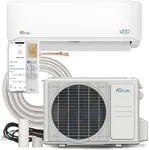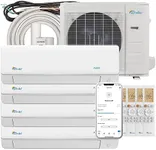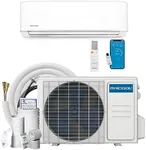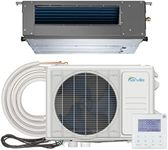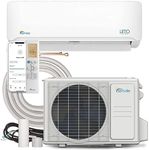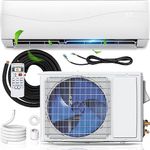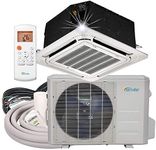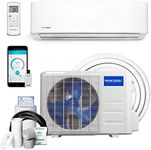Buying Guide for the Best Mini Split Heat Pumps
Choosing a mini-split heat pump can be a great way to efficiently heat and cool individual rooms or zones in your home without the need for ductwork. The right unit will keep you comfortable year-round, save on energy bills, and operate quietly. To make the best choice, it's important to understand the main features and specifications that affect performance, efficiency, and suitability for your space. By focusing on your room size, climate, and comfort preferences, you can narrow down the options and find a mini-split heat pump that fits your needs.BTU CapacityBTU (British Thermal Unit) capacity measures how much heating or cooling power the unit provides. This is important because a unit that's too small won't effectively heat or cool your space, while one that's too large can waste energy and cycle on and off too frequently. BTU ratings are usually divided into ranges like small (9,000–12,000 BTU) for bedrooms or small living rooms, medium (15,000–18,000 BTU) for larger rooms or open spaces, and large (24,000 BTU and above) for big areas or multiple connected rooms. To pick the right BTU capacity, consider the size of the room, ceiling height, insulation quality, and how much sunlight the space gets. There are online calculators to help estimate the right size, but as a rule, bigger rooms and colder climates need higher BTU ratings.
SEER and HSPF RatingsSEER (Seasonal Energy Efficiency Ratio) and HSPF (Heating Seasonal Performance Factor) are measures of how efficiently the unit cools and heats, respectively. Higher numbers mean better efficiency, which translates to lower energy bills and less environmental impact. SEER ratings typically range from 13 to 25+, and HSPF from 7 to 13+. For most users, a higher SEER and HSPF is better, especially if you plan to use the unit frequently or live in an area with extreme temperatures. If you only need occasional heating or cooling, a mid-range rating may be sufficient.
Number of ZonesMini-split systems can be single-zone (one indoor unit for one room) or multi-zone (multiple indoor units connected to one outdoor unit). This is important because it determines how many areas you can control independently. Single-zone systems are best for individual rooms, while multi-zone systems are ideal if you want to heat or cool several rooms or an entire floor. Think about how many spaces you want to control and whether you want separate temperature settings for each.
Compressor Type (Inverter vs. Non-Inverter)The compressor is the part of the heat pump that moves refrigerant and controls heating and cooling. Inverter compressors can adjust their speed to match the demand, making them more energy-efficient, quieter, and better at maintaining a steady temperature. Non-inverter compressors operate at full power or not at all, which can be less efficient and noisier. For most users, inverter models are preferable, especially if you value comfort, quiet operation, and lower energy use.
Operating Temperature RangeThis spec tells you the lowest and highest outdoor temperatures at which the unit can effectively heat or cool. It's important if you live in an area with very cold winters or hot summers. Some mini-splits are designed to work efficiently even when it's well below freezing outside, while others may struggle in extreme cold. Check the minimum and maximum operating temperatures and choose a model that matches your local climate, especially if you plan to use it as your main heating source.
Noise LevelNoise level, usually measured in decibels (dB), indicates how loud the indoor and outdoor units are during operation. Lower numbers mean quieter performance, which is important for bedrooms, offices, or living spaces where you want minimal disturbance. Typical indoor noise levels range from about 19 dB (very quiet) to 45 dB (moderate). If you’re sensitive to noise or installing the unit in a quiet area, look for models with lower dB ratings.
Air Filtration and Additional FeaturesMany mini-split heat pumps come with air filters or additional features like dehumidification, air purification, or smart controls. These can improve indoor air quality and make the system easier to use. If you have allergies, pets, or want to control the unit from your phone, look for models with advanced filtration or smart features. Consider which extras will actually benefit your lifestyle rather than just focusing on the basics.
